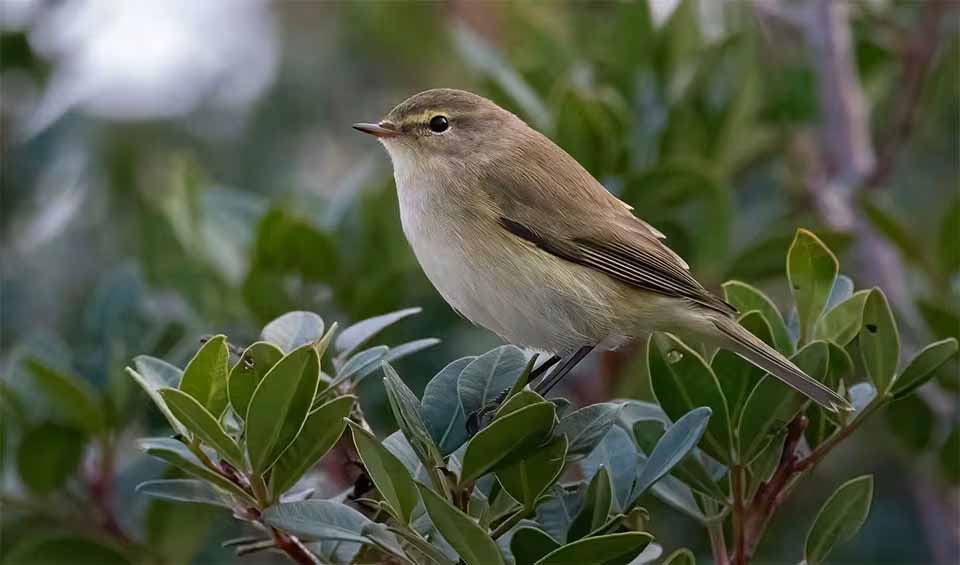A delightful and highly adaptable bird species known for its olive-brown upperparts and lighter, often yellowish, underside. This unassuming yet charming bird can be found thriving in a diverse range of habitats, including woodlands, parks, gardens, and scrubby areas across Europe, Asia, and parts of North Africa. Its ability to inhabit such varied environments speaks to its remarkable adaptability and resilience in the face of changing landscapes.
During the breeding season, the Common Chiffchaff announces its presence with its distinctive and repetitive “chiff-chaff” song, which echoes through the woodlands and fields. This energetic song serves both as a territorial marker and a courtship display, as males compete for the attention of potential mates. The rhythmic cadence of their song is a familiar sound of springtime in many regions.
Not only is the Common Chiffchaff, a skilled vocalist, but it is also an adept forager, constantly flicking its wings and tail as it flits about in search of insects and small invertebrates. Its agile movements and keen eye make it a formidable hunter, capable of capturing prey with impressive precision.
One of the most remarkable aspects of the Common Chiffchaff is its migratory behavior. Many individuals undertake impressive journeys between their European breeding grounds and wintering areas in southern Europe and North Africa. These migratory flights require careful navigation over long distances, highlighting the bird’s remarkable navigational abilities and endurance.
During the breeding season, Common Chiffchaffs construct cup-shaped nests in low vegetation or on the ground, using materials such as grass, leaves, and moss. Both parents participate in the incubation of the eggs and the care of the chicks, demonstrating a strong sense of parental cooperation and dedication to ensuring the success of their offspring.
Distribution
 Albania
Albania Algeria
Algeria Andorra
Andorra Armenia
Armenia Austria
Austria Azerbaijan
Azerbaijan Belarus
Belarus Belgium
Belgium Benin
Benin Bosnia And Herz.
Bosnia And Herz. Bulgaria
Bulgaria Burkina Faso
Burkina Faso Cameroon
Cameroon Chad
Chad Croatia
Croatia Cyprus
Cyprus Czechia
Czechia Côte D’ivoire
Côte D’ivoire DR Congo (Kinshasa)
DR Congo (Kinshasa) Denmark
Denmark Djibouti
Djibouti Egypt
Egypt Eritrea
Eritrea Estonia
Estonia Ethiopia
Ethiopia Faroe Islands
Faroe Islands Finland
Finland France
France Gambia
Gambia Georgia
Georgia Germany
Germany Ghana
Ghana Gibraltar
Gibraltar Greece
Greece Guinea-Bissau
Guinea-Bissau Guinea
Guinea Hungary
Hungary Iceland
Iceland Iraq
Iraq Ireland
Ireland Israel
Israel Italy
Italy Jordan
Jordan Kenya
Kenya Latvia
Latvia Lebanon
Lebanon Libya
Libya Liechtenstein
Liechtenstein Lithuania
Lithuania Luxembourg
Luxembourg Mali
Mali Malta
Malta Mauritania
Mauritania Moldova
Moldova Montenegro
Montenegro Morocco
Morocco Netherlands
Netherlands Niger
Niger Nigeria
Nigeria North Macedonia
North Macedonia Norway
Norway Poland
Poland Portugal
Portugal Romania
Romania Russia
Russia Rwanda
Rwanda Saudi Arabia
Saudi Arabia Senegal
Senegal Serbia
Serbia Seychelles
Seychelles Slovakia
Slovakia Slovenia
Slovenia Somalia
Somalia South Sudan
South Sudan Spain
Spain Sudan
Sudan Sweden
Sweden Switzerland
Switzerland Syria
Syria Tanzania
Tanzania Tunisia
Tunisia Turkey
Turkey UAE
UAE Uganda
Uganda Ukraine
Ukraine United Kingdom
United Kingdom Yemen
YemenAnything we've missed?
Help us improve this page by suggesting edits. Glory never dies!
Suggest an editGet to know me
Terrestrial / Aquatic
Altricial / Precocial
Polygamous / Monogamous
Dimorphic (size) / Monomorphic
Active: Diurnal / Nocturnal
Social behavior: Solitary / Pack / Herd
Diet: Carnivore / Herbivore / Omnivore / Piscivorous / Insectivore
Migratory: Yes / No
Domesticated: Yes / No
Dangerous: Yes / No




